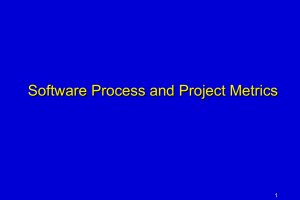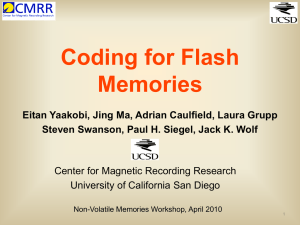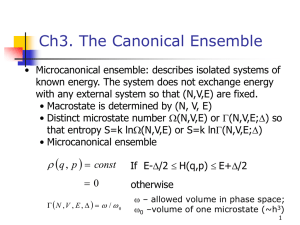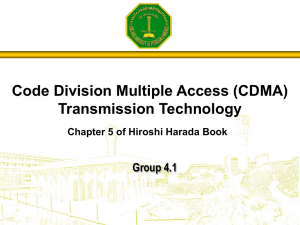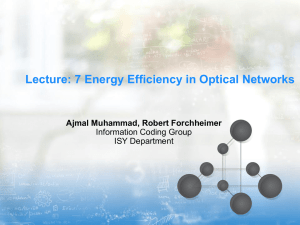Next Generation Optical NETworks NEGONET
advertisement
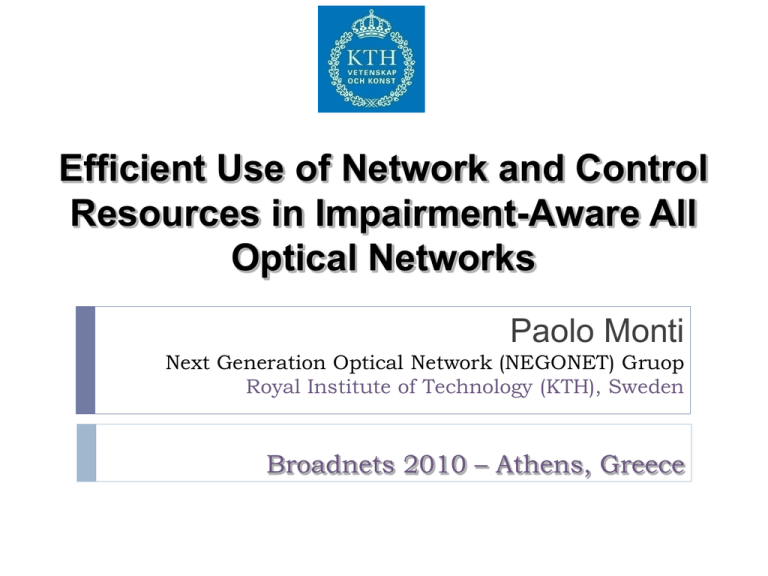
Efficient Use of Network and Control Resources in Impairment-Aware All Optical Networks Paolo Monti Next Generation Optical Network (NEGONET) Gruop Royal Institute of Technology (KTH), Sweden Broadnets 2010 – Athens, Greece Acknoledgements Amornrat Jirattigalachote Gabriel Junyent Kostas Katrinis Salvatore Spadaro Anna Tzanakaki Luis Velasco Lena Wosinska 2 Broadnets 2010 NEGONET Outline Transparent optical networks Lightpath provisioning considering optical impairments and different QoS levels NEGONET Impairment constraint based routing with service differentiation (ICBR-Diff) ICBR routing in a distributed scenario (set-up time, GMPLS extensions) Impairment-aware probabilistic provisioning method Performance assessment Conclusions 3 Broadnets 2010 Optical transparency Lightpaths routed from source to destination entirely in the optical domain Pros Cost reduction (less O/E/O conversion) High bit rate, less energy consumption and protocol transparency Cons 4 NEGONET Physical medium not ideal (i.e., optical physical impariments) Optical signal degradation Less signal regeneration opportunities Broadnets 2010 Outline Transparent optical networks Lightpath provisioning considering optical impairments and different QoS levels NEGONET Impairment constraint based routing with service differentiation (ICBR-Diff) ICBR routing in a distributed scenario (set-up time, GMPLS extensions) Impairment-aware probabilistic provisioning method Performance assessment Conclusions 5 Broadnets 2010 Traditional ICBR RWA algorithm considers resource availability and physical layer parameters Q-penalty used as routing parameter NEGONET link cost in the routing algorithm the path with lowest level of impairments Q-factor evaluation Amplified Spontaneous Emission Noise (ASE) Cross-Phase Modulation (XPM) Four-Wave Mixing (FWM) Optical Filtering Self-Phase Modulation / Group Velocity Dispersion Path quality measured in terms of Bit Error Rate (BER) BER calculated through quality factor Q and compared against predefined threshold (e.g., BERthresh= 10-15) 6 Broadnets 2010 Different QoS requirements NEGONET Next-Generation Internet will need to support a variety of services High definition television (HDTV) Audio Video On Demand (AVOD) Peer-to-peer (P2P) applications Traditional ICBR schemes Select the path with minimum BER (Impairment-Aware Best-Path IABP) Single signal quality requirement Issue: no QoS differentiation and unnecessary blocking of requests 7 Broadnets 2010 The ICBR-Diff intuition NEGONET Impairment Constraint Based Routing with service differentiation Different service classes with different signal quality requirements Class-1: require high signal quality Class-2: tolerate lower signal quality Etc. Assign to each connection resources that are good enough to satisfy the BER requirements of a class Path selection mechanism ICBR-Diff selects the path with maximum acceptable BER from a set of candidate paths 8 Broadnets 2010 Path selection example NEGONET 10-15 Class-1: BER < Class-2: BER < 10-9 BER of 5 feasible routes = [10-8, 10-10, 10-12, 10-16, 10-18] Class-1 request 9 ICBR-Diff IABP Broadnets 2010 Path selection example NEGONET 10-15 Class-1: BER < Class-2: BER < 10-9 Allocates better resources than necessary BER of 5 feasible routes = [10-8, 10-10, 10-12, 10-16, 10-18] IABP Class-2 request ICBR-Diff No service differentiation! Best path above the threshold: 10-15 10 Broadnets 2010 ICBR-Diff: algorithm NEGONET k-shortest path algorithm Initialization phase collect: -Network topology information - Physical parameters Route found Path selection: check BER according to the request’s class Connection request Route not found Block! BER higher than threshold Block! Assign link cost: BER lower than threshold Q-penalty 11 Assign wavelength: First Fit Broadnets 2010 Performance study Poisson arrival of connection requests and exponentially NEGONET distributed service time Bandwidth of connection request: one wavelength unit No wavelength conversion Derivation of BER assumes all wavelengths on a fiber occupied (worst case analysis) Two classes of connection requests Two cases for traffic mix of Class-1 and Class-2 requests Class-1: requiring BER < 10-15 Class-2: requiring BER < 10-9 Class-1 -- Class-2 = 30%--70% Class-1 -- Class-2 = 50%--50% Pan European Cost 239 network topology (11 nodes 26 bifibers, 16 wavelength per fiber) 12 Broadnets 2010 Results: total blocking NEGONET Traffic mixes Shortest Path IABP (10-15) 30/70 90% 83% 50/50 80% 66% Lightpaths with acceptable BER with respect to the signal quality requirement of each specific service class High quality links are kept for demanding services Efficient utilization of network resources A. Jirattigalachote, P. Monti, L. Wosinska, K. Katrinis, A. Tzanakaki, “ICBR-Diff: an Impairment Constraint Based Routing Strategy with Quality of Signal Differentiation,” Journal of Networks, Special Issue on All-Optically Routed Networks, 2010. 13 Broadnets 2010 Lower blocking probability Survivability study NEGONET Performance of ICBR-Diff when protection is required Optical physical impairments considered also while computing the protection path Path protection with link (single) failure assumption 14 Dedicated path protection scheme Shared path protection scheme Broadnets 2010 Survivable ICBR-Diff NEGONET Protection Path Provisioning Phase Primary Path Provisioning Phase k-shortest path algorithm Initialization phase collect: 1 -Network topology information - Physical parameters -Dedicated path: routing scheme Assign link cost: -Shared path: Q-penalty (i) Already shared wavelength: zero (ii) Free wavelength: routing scheme 15 Block! Route found Path selection: check BER according to the request’s class Connection Exclude the links used in request primary path Assign link cost: Route not found BER higher than threshold Block! BER lower than threshold Assign wavelength: First Fit Broadnets 2010 1 Dedicated path protection NEGONET 16 Traffic mixes Shortest Path IABP (10-15) 30/70 37% 33% Broadnets 2010 A. Jirattigalachote, L. Wosinska, P. Monti, K. Katrinis, and A. Tzanakaki, “Impairment Constraint Based Routing (ICBR) with Service Differentiation in Survivable WDM Networks”, in Proc. of ECOC, 2009. Shared path protection NEGONET Provides a lightpath that has acceptable BER performance with respect to the signal quality requirement of each service class request More efficient resource utilization Avoid unnecessary blocking 17 Traffic mixes Shortest Path IABP (10-15) 30/70 61% 17% Broadnets 2010 A. Jirattigalachote, L. Wosinska, P. Monti, K. Katrinis, and A. Tzanakaki, “Impairment Constraint Based Routing (ICBR) with Service Differentiation in Survivable WDM Networks”, in Proc. of ECOC, 2009. Outline Transparent optical networks Lightpath provisioning considering optical impairments and different QoS levels Impairment constraint based routing with service differentiation (ICBR-Diff) ICBR routing in a distributed scenario (set-up time, GMPLS extensions) NEGONET Impairment-aware probabilistic provisioning method Performance assessment Conclusions 18 Broadnets 2010 Physical layer impairments NEGONET Physical layer impairments classified into: Affect each of the wavelengths individually Cause interference between wavelengths e.g., Attenuation, ASE noise, CD, PMD, SPM e.g., XPM, FWM With interference between wavelength, lightpaths already established are also affected Distributed provisioning protocol has to account for this effect while deciding on whether to route a lightpath or not 19 Broadnets 2010 Impairments estimation in a distributed scenario NEGONET Current state of the network: impairments computed and checked at each provisioning Worst case scenario: impairments fixed penalties for each link assuming that all wavelength are used Current information, need to extend the GMPLS protocol set Set-up times are long for on-line Q-factor computation Short lightpath set-up time (the Q-factor can be pre-computed beforehand for each link) No need for GMPLS protocol extensions Blocking probability (might) unnecessarily high A probabilistic approach: a prediction on the maximum number of used wavelengths in every link in the network 20 Broadnets 2010 Probabilistic Model NEGONET G(N, E, W) optical network graph δ: the average nodal degree H : the average hop length of a lightpath. H~((|N|-2)/(δ-1))1/2 C: the average number of established lightpaths for a given offered load λ: the average number of used wavelengths in a link, λ=C·H/|E| Cumulative distribution of maximum number of used wavelengths in every link 1 W l P (Y l ) 2 W P(Y>λl) 1 1 P X l 100% Low Load Medium Load High Load 75% 50% 0% 0 2 21 4 6 8 10 12 14 16 0 2 4 6 8 10 12 14 16 λl 8 16 24 32 40 48 3 5 7 9 10 11 Load (E) 56 64 72 80 88 96 Max wav. (λl) 12 13 14 14 15 16 10% 25% Load (E) Max wav. (λl) λl 0 2 4 6 8 10 12 14 16 λl Broadnets 2010 ASE, XPM and FWM noise variance 1.9E-4 Search order which spreads the used wavelengths as much as possible Minimal total variance and better lightpath Q-factor value Q-factor estimation is based on the impairments over the central wavelength (worst case) NEGONET σ2ASE+ σ2XPM + σ2FWM 1.8E-4 1.7E-4 1.6E-4 1.5E-4 Link: 540km 1.4E-4 1 3 5 7 9 11 Used Wavelengths (λi) Wavelength # 1 2 Search order 6 11 13 4 15 2 9 1 10 3 22 3 4 5 6 7 8 9 10 11 12 13 14 15 16 16 5 Broadnets 2010 14 7 12 8 13 15 Blocking Probability (Pb) NEGONET Pb (%) 20% Simulations with 16 node EON COST266 reference network) every link with 16 wavelengths Q threshold = 7.4 BER ≈ 6.8 10-14 18% 16% no-IaFF IaWC IaCS IaPC 14% 12% 10% 8% 6% 4% 2% 0% 8 16 24 32 40 48 56 64 72 80 Load (Erlangs) L. Velasco, A. Jirattigalachote, P. Monti, L. Wosinska, S. Spadaro, G. Junyent, “Probabilistic-Based Approach for Fast Impairments-Aware RWA in All-Optical Networks,” in Proc of OFC, 2010. 23 Broadnets 2010 88 96 Impairments Availability NEGONET Ia Unavailability With Ia-CS and Ia-WC each established lightpath with BER better than or equal to the threshold The constraint relaxed with IaPC approach Unavailability: ratio between lightpath experience BER>threshold and the total time the lightpath is established in the network 1E+0 1E-1 1E-2 1E-3 1E-4 1E-5 1E-6 1E-7 8 16 24 32 40 48 56 64 72 80 Load (Erlang) L. Velasco, A. Jirattigalachote, P. Monti, L. Wosinska, S. Spadaro, G. Junyent, “Probabilistic-Based Approach for Fast Impairments-Aware RWA in All-Optical Networks,” in Proc of OFC, 2010. 24 Broadnets 2010 88 96 Conclusions ICBR routing with QoS levels NEGONET ICBR-Diff approach where path with maximum acceptable BER (good enough) is selected (both primary and secondary) Significant blocking probability improvement against conventional ICBR ICBR routing in a distributed scenario 25 ICBR-PC approach with a contained set-up time and with no extensions for GMPLS protocol Blocking probability comparable with exact ICBR approaches with acceptable level of unavailability Broadnets 2010 Thank you!! contact: pmonti@kth.se www.ict.kth.se/MAP/FMI/Negonet/
